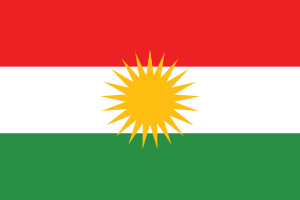Kurds in Israel
| Total population | |
|---|---|
| 50-150 | |
| Languages | |
| Kurdish | |
| Religion | |
| Sunni Islam, Yazidi faith, Alevism |
Kurds in Israel refers to people of Kurdish origin residing in Israel. The Kurdish population in Israel is small and is mainly composed of individuals and families, who fled Iraq and Turkey during the Iraqi-Kurdish and the Kurdish-Turkish conflicts during the 20th century, as well as temporal residents arriving in Israel for medical care.
Population
The Kurdish population in Israel is small and is mainly composed of individuals and families, who fled Iraq and Turkey during the Iraqi-Kurdish and the Kurdish-Turkish conflicts during the 20th century. They numbered some 150 persons in 2007.
In March 2001, a group of 19 Kurdish men entered Israel via Lebanon, asking for asylum, but were denied.[1] In mid-2001, a group of 42 Kurdish refugees attempted to enter Israel via Lebanon, illegally crossing the Israeli-Lebanese border, but were returned to Lebanon.[2]
In 2007, 40 Iraqi Kurdish children, mostly from Iraqi Kurdistan, were hosted with their parents and medically treated in Israel, as part of the project initiated by Israeli Save a Child’s Heart Organization (SACH).[3] In 2013, it was reported that Israel accepted three Kurdish children from Iraqi Kurdistan for medical treatment.[4] The children were settled into Wolfson Medical Center in Holon, southern Tel Aviv area. They were some of the 183 children with Iraqi nationality, entering Israel for medical treatment since the establishment of the program.
In January 2015, Yazidi organizations made an official request from Israeli government to absorb Yazidi refugees from Iraq. There was no official statement by Israeli government as a result, but Yazidi sources claimed that refugee absorption took place and thanked Israeli government.[5] There was no response from Israeli Parliament members, upon asking them on this matter of absorbing Yazidi refugees.[6]
See also
References
- ↑
- ↑ "נדחתה בקשתם של 42 כורדים למקלט מדיני". 10 August 2001 – via Haaretz.
- ↑ Technologies, Slavin-Internet. "IMA -".
- ↑ "Kurdish children from Iraqi Kurdistan receive medical treatment in Israel".
- ↑ "News1 - האם ייתכן שישראל קלטה פליטים יזידים".
- ↑ "Israel's Yazidi 'ambassador' explains why so many want to join the IDF".
